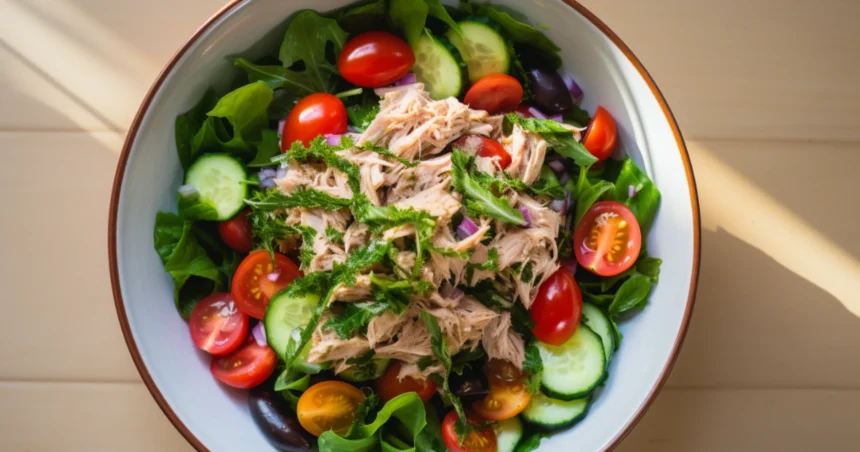Tuna salad is a classic protein-packed dish, but is tuna salad healthy? To answer that key question, it’s important to look at the various components that go into tuna salad and examine the health implications of each ingredient. Tuna salad is made by combining canned tuna with mayonnaise and other ingredients like celery, onion, and relish.
It’s a popular choice for an easy lunch or light dinner, and many people view tuna salad as a relatively nutritious meal option. But to determine if tuna salad is truly a smart, healthy choice that aligns with your fitness goals, you need to understand the nutritional value of what goes into it. By diving into the health aspects of the standard tuna salad recipe, you can see if you need to make modifications to boost its benefits. The healthfulness of tuna salad is conditional on preparation and ingredients used.
Components of Tuna Salad and Their Health Implications
The Role of Mayonnaise
Mayonnaise is a standard ingredient in tuna salad, but it can really load up the calories and fat. Traditional mayonnaise is an emulsion of egg yolks, oil, and an acid like vinegar or lemon juice. Just one tablespoon of mayo packs about 90 calories and 10 grams of fat. That’s nearly all from unhealthy saturated fat. When you’re making a full batch of tuna salad to eat over multiple meals, you could easily end up using a half cup or more of mayo. That can add several hundred calories and significantly jack up the fat content. Too much mayonnaise diminishes the nutrition value of tuna salad and makes it more of a high-fat, high-cal indulgence. The mayo is what pushes it from a protein-packed lunch to a meal that needs some nutritional tweaking.
Nutritional Benefits of Tuna
Now let’s talk about the tuna itself. Canned tuna is nutritionally dense, packing protein, vitamins, and minerals into just a 3-4 oz serving. Tuna provides B vitamins like niacin, B6, and B12. These support energy levels and metabolic function. The omega-3 fatty acids in tuna are linked to improved heart health. Tuna also contains the antioxidant mineral selenium, which enhances immune function. As for vitamins, a serving of tuna has vitamin A for healthy vision, vitamin D for bone health, and vitamin K for proper blood clotting. Additionally, tuna provides iron which prevents anemia and allows red blood cells to effectively transport oxygen. When paired with whole grains or veggies, the iron is more readily absorbed too. So the tuna itself delivers some excellent nutritional perks. It’s a lean source of high-quality protein and has a solid lineup of vitamins and minerals.
The Significance of Portion Size
To maximize the health benefits of tuna salad, it’s important to pay attention to portion sizes. Stick to around 3-4 oz of tuna per serving, which provides about 20+ grams of protein for muscle repair and satiety. Bulk up the volume with nutrient-dense vegetables instead of relying solely on starchy fillers like pasta or bread. Some healthy add-ins are diced celery, shredded carrots, chopped cucumbers, or grape tomatoes. These boost the vitamin, mineral, and fiber content. Not only does this provide more nutritional value, but it also helps you avoid overdoing it on the tuna. Consuming large amounts of tuna frequently can lead to excessive mercury exposure. So a modest tuna portion combined with veggie additions lets you enjoy the benefits while minimizing risks.
Sodium Content in Tuna Salad
Here’s an area where tuna salad can get unhealthy – its sodium content. Canned tuna often contains added salt as a preservative. Just one can might have 300-500 mg of sodium. When you’re combining this with high-sodium mayo, pickles, olives, or other salty ingredients to make tuna salad, it can quickly reach dangerous levels. Consuming excessive sodium is linked to high blood pressure, heart disease, stroke, and other health risks. The American Heart Association recommends limiting sodium to 1500 mg per day at most. To keep tuna salad’s salt content in check, choose low-sodium or no-salt-added canned tuna whenever possible. Also use reduced-sodium mayonnaise or Greek yogurt instead. Skip olives, pickles, and other salty add-ins. And enhance flavor with lemon juice, garlic, onions, herbs, and black pepper instead of salt. With a few simple swaps, you can still enjoy flavorful tuna salad while avoiding excess sodium.
Making Healthier Tuna Salad Choices
Alternatives to Mayonnaise
Alright, let’s talk mayo alternatives! You might think, “Can anything truly replace the creamy goodness of mayo?” The answer is a resounding yes! Greek yogurt, for one, is a fantastic substitute. It offers a creamy texture but with a fraction of the calories and fat. Plus, it’s packed with protein and probiotics, which are a boon for your gut health. Another intriguing option? Silken tofu. Before you raise an eyebrow, hear me out. It’s a plant-based alternative that, when blended, takes on a mayo-like consistency, and it’s rich in plant proteins and minerals. Both these alternatives are not just healthier but can add a unique twist to your tuna salad.
Vegetable Additions
Don’t stop at just tuna and a mayo substitute when making tuna salad. Vegetables provide valuable vitamins, minerals, and fiber with barely any calories. Chopped celery is a classic for giving some crunch. Other options are diced onion, shredded carrots, chopped cucumbers, or grape tomatoes. You can also add things like chopped mushrooms, bell peppers, spinach, kale, or broccoli slaw mix. The veggies will make your tuna salad more nutritionally complete. They also let you bulk up the volume so you get plenty to eat without overdoing it on the tuna and mayo. Adding a variety of colorful vegetables gives you more nutritional bang for your buck.
Opting for Low-sodium Canned Tuna
Last but not least, when shopping for canned tuna, always eye for the low-sodium or no-salt-added labels. Sodium, as we’ve discussed, can be a silent health saboteur. By choosing low-sodium tuna, you’re taking a proactive step to maintain healthy blood pressure levels and overall heart health. And trust me, with the right mix of ingredients, you won’t even miss the extra salt!
Final Thoughts
In examining the common ingredients in tuna salad, it’s clear there are both healthy and unhealthy aspects to balance. The tuna itself packs protein, Omega-3s, vitamins, and minerals. But the typical mayonnaise can add excessive saturated fat and sodium. Paying attention to portion sizes, adding veggies, and choosing low-sodium options helps maximize nutrition.
With the right modifications, tuna salad can be a protein-rich and nutritious lunch or dinner option. But if you overload it with mayo, salty add-ins, and starchy sides, its benefits diminish. The healthfulness of tuna salad comes down to preparation. When made with light mayo alternatives, lots of vegetables, and controlled sodium and portions, tuna salad can be a wholesome meal. It takes some tweaking to optimize tuna salad, but with smart ingredient swaps it can fit into a healthy lifestyle.









